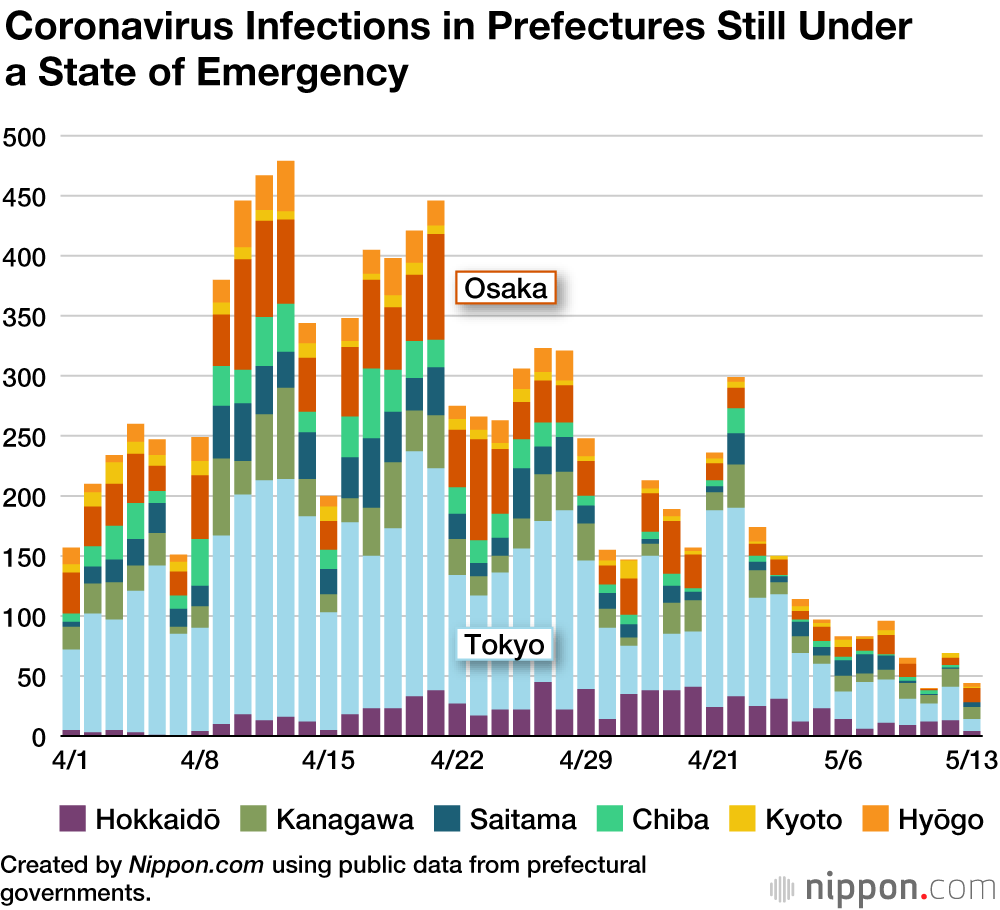
Coronavirus Crisis: Japan Lifts State of Emergency in All But Eight Prefectures
Politics- English
- 日本語
- 简体字
- 繁體字
- Français
- Español
- العربية
- Русский
On May 14, the Japanese government, following consultation with an advisory panel, lifted the state of emergency over the coronavirus in 39 of the country’s 47 prefectures. The raising of the declaration includes areas that had seen relatively few COVID-19 cases as well as Ibaraki, Ishikawa, Gifu, Aichi, and Fukuoka, which were among 13 prefectures designated for stepped-up measures.
The state of emergency will remain in effect in Chiba, Hokkaidō, Hyōgo, Kanagawa, Kyoto, Osaka, Saitama, and Tokyo with a decision to be made later on whether to lift it in these prefectures on May 21 ahead of the current planned end on May 31. The graph shows how new cases in these areas peaked in the first two weeks after the state of emergency was initially announced on April 7, before showing a subsequent downward trend.
COVID-19 and Japan: A Timeline
| May 31 | Current planned end of state of emergency. |
| May 21 | Decision to be made on possible lifting of state of emergency in remaining eight prefectures. |
| May 14 | State of emergency lifted in 39 prefectures. |
| May 6 | Original planned end of state of emergency. |
| May 4 | Nationwide state of emergency extended to May 31. |
| May 4 | Global cases rise above 3.5 million. |
| May 2 | Fatalities in Japan rise above 500. |
| April 30 | Supplementary budget including ¥100,000 payments to all residents enacted. |
| April 28 | Cases in Tokyo rise above 4,000. |
| April 18 | Cases in Japan rise above 10,000. |
| April 16 | State of emergency expanded nationwide. |
| April 14 | Ceremonial investiture of Crown Prince Fumihito postponed. |
| April 12 | Cases in Tokyo rise above 2,000. |
| April 11 | Global fatalities rise above 100,000. |
| April 7 | State of emergency declared in the prefectures of Tokyo, Kanagawa, Saitama, Chiba, Osaka, Hyōgo, and Fukuoka. |
| March 30 | Tokyo Governor Koike Yuriko calls on residents to refrain from attending karaoke outlets, concert venues, bars, and nightclubs. |
| March 29 | Comedian Shimura Ken dies of COVID-19. |
| March 25 | Tokyo Governor Koike urges residents to refrain from going outside at the weekend, warning of the danger of an explosive rise in infections. |
| March 24 | The Tokyo Olympics and Paralympics are postponed until 2021. |
| March 13 | The enactment of new legislation makes it possible to declare a state of emergency over COVID-19. |
| March 11 | The World Health Organization declares that the COVID-19 outbreak is a pandemic. |
| February 28 | Hokkaidō declares a state of emergency, calling on residents to refrain from leaving home on the weekend. The state of emergency lasts until March 19. |
| February 27 | Prime Minister Abe calls for the closure of all Japanese elementary, junior high, and high schools from March 2. |
| February 3 | The cruise ship Diamond Princess arrives in Yokohama. Many infections are later discovered on the ship. |
| January 16 | The Ministry of Health, Labor, and Welfare announces the first case in Japan. |
(Originally published in Japanese. Banner photo: © Pakutaso.)
